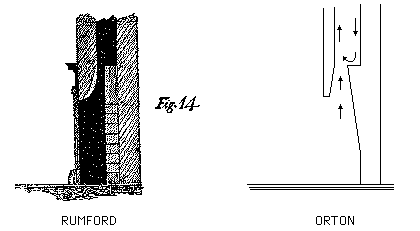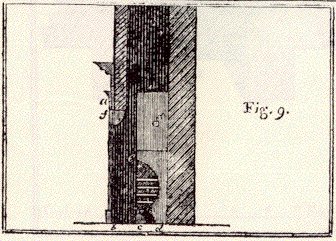Real Rumford's
Straight Backs and Rounded Breasts
by Jim Buckley, 12/18/90
|
As soon as Rumford's first essay on fireplaces was published and well into the 19th century a number of people attempted to explain why Rumford fireplaces worked so well even though they didn't really understanding the basic principles of radiant heat and fluid dynamics, or "the principles of pneumatics" in Rumford's words, that we now take for granted. A common, but totally erroneous, explanation of Rumford's principles dating from that time was the idea put forward by Thomas Danforth that Rumford's great contribution was the smoke shelf which blocked downdrafts in the back of the chimney and physically turned them around and made them into updrafts. If one understands what Rumford did - essentially made big square inefficient fireplaces more shallow - one can see that the smoke shelf was merely the inadvertent result of building the new fireback forward, up about as far as the mason could reach. Rumford did say that the smoke shelf should be made flat to discourage downdrafts, but it is a misreading of Rumford to embellish this comment into the now discredited 19th century theory of air moving in two directions at the same time within a chimney - a theory repeated by Orton who erroneously attributed it to Rumford. It was also during the early 1800's that the slant-backed Rumford variation that Orton describes was popularized. In his first essay, toward the end of the second chapter devoted to "Practical Directions ... for Workmen", Rumford summed up his general principles and then discussed two special cases. The first was to say that with small fireplaces it was ok to make the fireback a little wider than one third of the opening width to accommodate an existing grate for burning wood, rather than going to the trouble of getting a new grate. The other special case involved making a very small fireplace a little deeper by slanting the back wall of the firebox a few inches back right over the fire. |
If he had kept the fireback vertical as he did in all the other fireplaces he improved, the firebox would have only been about 8" deep. Rumford thought it should be about 12" deep to be big enough to maintain a fire. In a footnote he said that particular fireplace seemed to be an especially good heater and he wasn't sure why. Perhaps it was the additional radiation off the slanted back wall. He never came back to the subject and there is no evidence that he ever built any other fireplaces with slanted firebacks. Yet this footnote was tantalizing, and many people took this exception to be the rule - the best of Rumford - usually getting the geometry of the slant wrong, as Orton does, and neglecting to round the breast. In 1804 James Meese, editor of the first American edition of the Domestic Encyclopedia, reprinted nearly all of Rumford's first essay under the "fireplace" entry. He did, however, do some editing. He excluded most of the asides and long-winded passages about how his improvements made rooms more comfortable and more "salubrious". He also edited out nearly all of Rumford's references to the importance of "rounding the breast". Presumably, like Jefferson, Meese didn't understand the importance of streamlining, although he did reprint Rumford's plate showing a straight-backed fireplace with rounded breast. Meese also said his objective was to make "additions applicable to the present situation of the United States" and in this vein he added emphasis to Rumford's two special cases making it look as if in America, if you wanted to burn wood on the hearth, you should make the fireboxes a little wider in the back and slant the back wall to make the fireplaces a little deeper.
|
|
There was probably a shorter more practical manual for masons and builders on how to build a Rumford fireplace, based on Danforth's essay or the Domestic Encyclopaedia. It would have been published sometime between 1805 and 1810, and included a new simplified drawing more like Orton's than Rumford's, but I haven't found it. Libraries didn't tend to keep these unscholarly works, but it must have been widely read, if ephemeral. Vrest Orton's Rumford variation is in this tradition. I have no doubt that Mr. Orton accurately described the fireplace in his home in Vermont. I have seen many fireplaces said to be Rumfords which had slanted backs. While it's a common variation, it's not a Rumford. It's not even a true representation of Rumford's little fireplace special case, which only had a niche or short slanted wall "quite finished 8 or 10 inches above the fire" and a rounded breast.
|
The Orton Rumford does work, I'm told, although they are prone to smoke. Neglecting to streamline the throat means that there is turbulent (rather than laminar) air flow through the throat. But fortunately, by bringing the fireback forward, the throat ends up being wider than it would be if it were kept at the back. The fireplace Orton describes has a throat which is about 28" wide by 4" deep compared with the throat of a straight-backed Rumford of the same size which would be about 16" wide by 4" deep. Orton's throat is almost twice as big as it should be. Good thing though. Because his throat is not rounded or streamlined, it needs to be bigger to handle all that turbulence. It would be interesting to see if there is more radiation from the slanted back of Orton's fireplace and, if so, is it's benefit offset by the additional air loss caused by the oversized throat. I have simply tried to build Rumford fireplaces as Rumford built them - not improve upon them. If I could build a better fireplace I'd call it a Buckley fireplace.
|

About the author, Jim Buckley
Reader Comments
Rumford's 1796 and 1798 Essays on Chimney Fireplaces
Buckley Rumford Fireplaces
Copyright 1995 - 2011 Jim Buckley
All rights reserved.
webmaster

